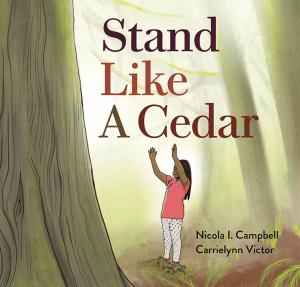
Stand Like a Cedar
Stand Like a Cedar is a beautiful picture book that provides an opportunity to explore a number of important themes within a classroom. It offers learners a window through which to explore concepts of environment, seasons, family, traditions, mindfulness and Indigenous languages, among others. It asks us to stop in nature and attend to what is happening all around us.
Exquisitely written and illustrated, each page offers an opportunity to explore the details. Importantly, it includes vocabulary from the Salish (Coastal and Interior) language family providing an opportunity to discuss what has happened to Indigenous languages through colonization as well as the importance of relearning native languages.
The book is a suitable read-aloud for primary and some junior grades, with possible links to Social Science (Heritage and Identity and People and Environments: local community). It includes a glossary and a translation guide. This is a key component for respectfully learning new terms; it also gives students a chance to develop an understanding of text features (Language Arts, Reading for Meaning, Grade 3.)
One of the stand-out components of this book is its connection to what is happening in the natural world. It shows children moving through their world at a pace that invites reflection and mindfulness. Narrators remark on warm land beneath their feet, the brightness of morning, the rain on their skin. They paddle, walk, run, gather and prepare food. They connect their experience with those of their ancestors. Students can follow suit, taking time to observe and describe the natural world and their place within it.
While it’s crucial to actively and specifically discuss Indigenous histories and cultures in our classrooms, it is equally important to “indigenize our curriculum.” In short, we can incorporate books and images that represent Indigenous perspectives without making that the specific focus. Stand Like a Cedar provides opportunities to stretch into various spheres, even when we are not talking about indigeneity specifically. The ability to talk about seasons, the natural world, traditions and family relations allows us to revisit the book over the course of the year should we choose to. Students can enjoy the art, language and reflections in this book within a broader context.
Ontario educators are fortunate to have this book. Students will be engaged by its content and enjoy many conversations and themes that emerge from its pages.
Martha Brown is a member of the Ottawa-Carleton Teacher Local.